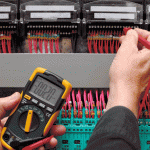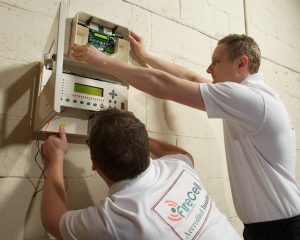Green Tree Safety has field-based engineers who specialise in Fire Alarm fault finding and repair.
Our 24-hour staffed helpline is available for emergency situations and we can conduct work out-of-hours to service your fire alarm system with minimal disruption to the rest of the business.
We work with all makes of Fire alarm systems and carry spares for the most prevalent models, such as Twinflex, Apollo, Gent, EMS, FireSmart, Kentec, Hochike, Fike and MXPro. Our skilled engineers are also qualified to work on closed protocol systems like ADT.
If your system is showing a fault, call us today to arrange for an engineer to call. Our engineers are trained in the process of identifying faults on all types of alarm systems; some of the more frequent problems we deal with include:
 Intermittent earthing problems in the power supply
Intermittent earthing problems in the power supply- Damaged to the loop of cables that form the Fire Zone
- Out-of-date backup batteries
- Detector heads that have reached end of life (typically 10 years)
- Power surges
- Devices have become loose, which cause a tamper fault
- Detector heads have become contaminated; dust can cause this
- Alterations to buildings can cause problems with wireless systems, as the signal requires a clear radio path
WHY GREEN TREE SAFETY?
Since we founded Green Tree Safety back in 2006, we have performed over five thousand service calls on fire alarm systems alone.
In the UK, the British Standards Institute dictate the standard that your system must conform to – BS 5839 Part 1. All of Green Tree Safety’s engineers are trained to this standard as a minimum.
We provide comprehensive services through our in-house dedicated professionals. Our experience is such that a number of our customers entrust our engineers as their dedicated “Competent Person” – in these cases, we also become key-holders and automatically attend in the event of any fault.

In addition to servicing and maintenance, we also provide full design and installation of fire detection and alarm systems, including a free initial consultation and comprehensive post-installation training.
Call us today on 08000 24 11 24 to find out more about how we can help.
SOME TYPICAL FAULTS
Faults will usually be identified by a flashing light on the fire panel, probably with an accompanying buzzer or persistent activation sound. If you are unsure as to which device may be faulty, first take a look at each fire detector to see if there’s a flashing or permanent light. If there is any obvious visual difference from other devices connected to your system, the device is likely to be faulty.
Older fire alarm call points have a small, breakable glass panel – these can easily be broken by accident. If this happens, you won’t be able to reset the fire panel without first replacing the glass panel. Newer alarm call points have a plastic panel instead that can be easily reset.
Your fire system will have a certain degree of in-built fault monitoring. For example, the power circuit; this is continuously monitored to ensure there is 230v mains power to the system. If you should have a power cut, the system will switch to an internal backup battery that should provide enough power to run for 24hrs. Another example would be end of line (EOL) resistors, which are fitted to the end of each zone. These resistors inform the panel that the cabling is intact and there are no broken connections – damage caused by rodents knowing on cabling is not uncommon.
Some advanced systems may also have an event log that can be examined to identify what faults have occurred and where they may lie. These are usually referred to as Analogue Addressable systems and are far more sophisticated than non-addressable panels, providing far more information on the fire alarm system status.
If you’ve encountered any problems like these with your alarm system, call us for help – we may be able to explain how to reset your system over-the-phone.
